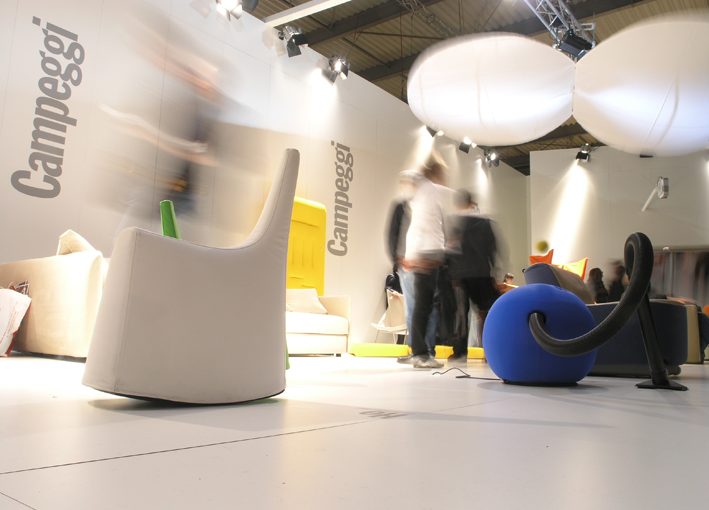This was the second full review of the fair that I did for Modern Weekly. I used the opportunity to meet two heroes of mine: Denis Santachiara and Claudio Campeggi.
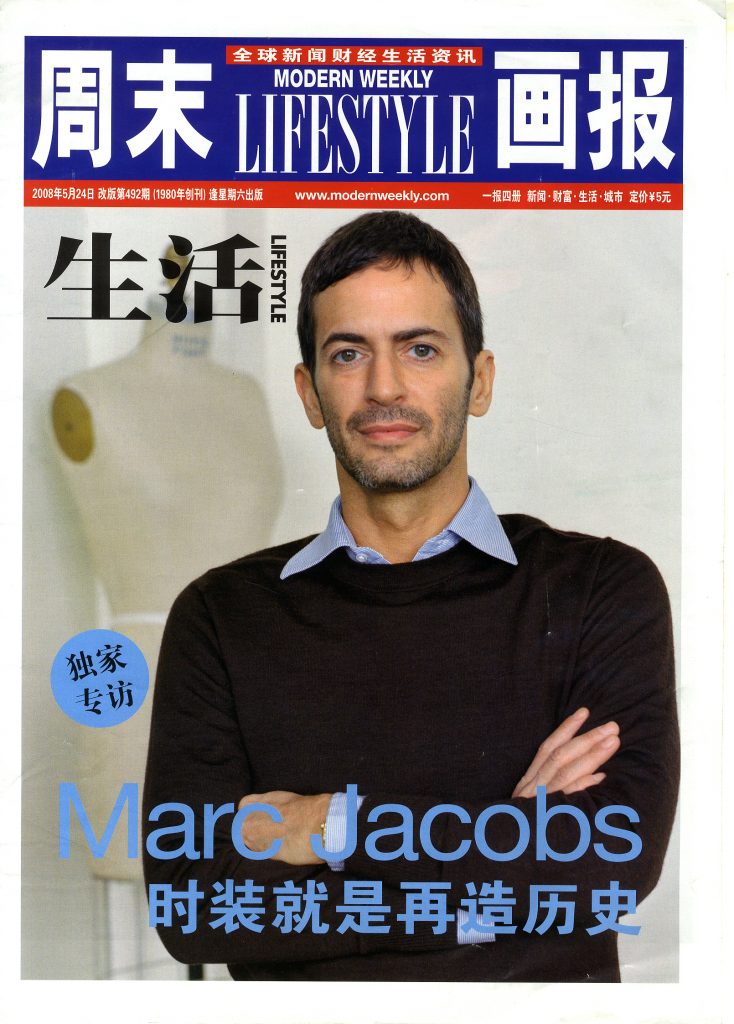

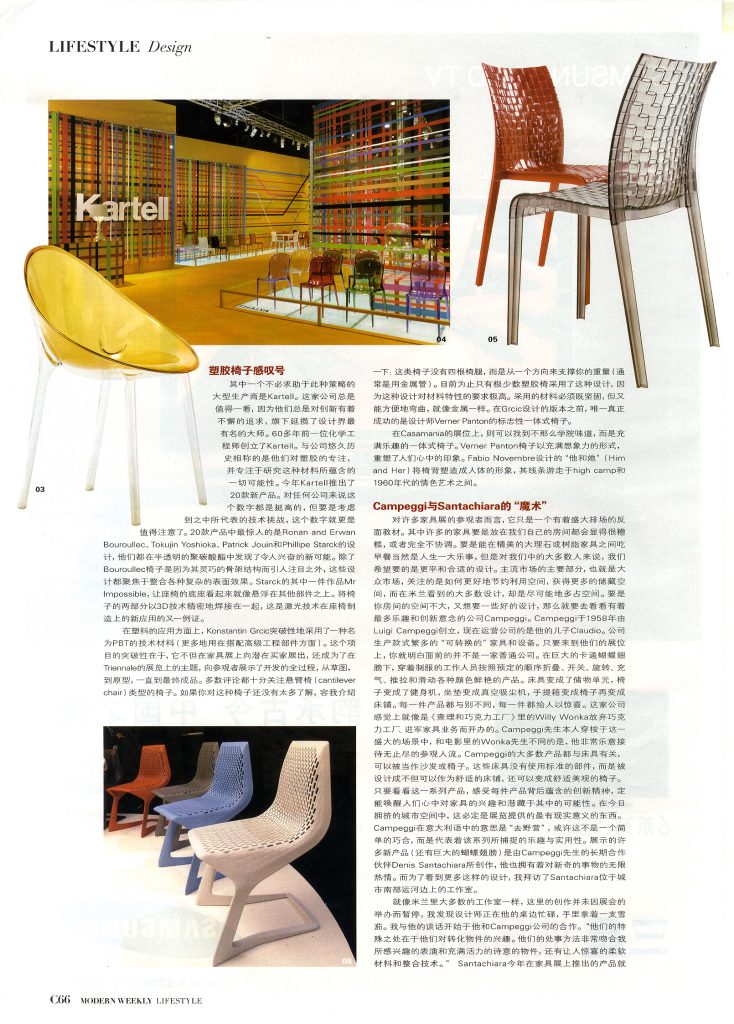
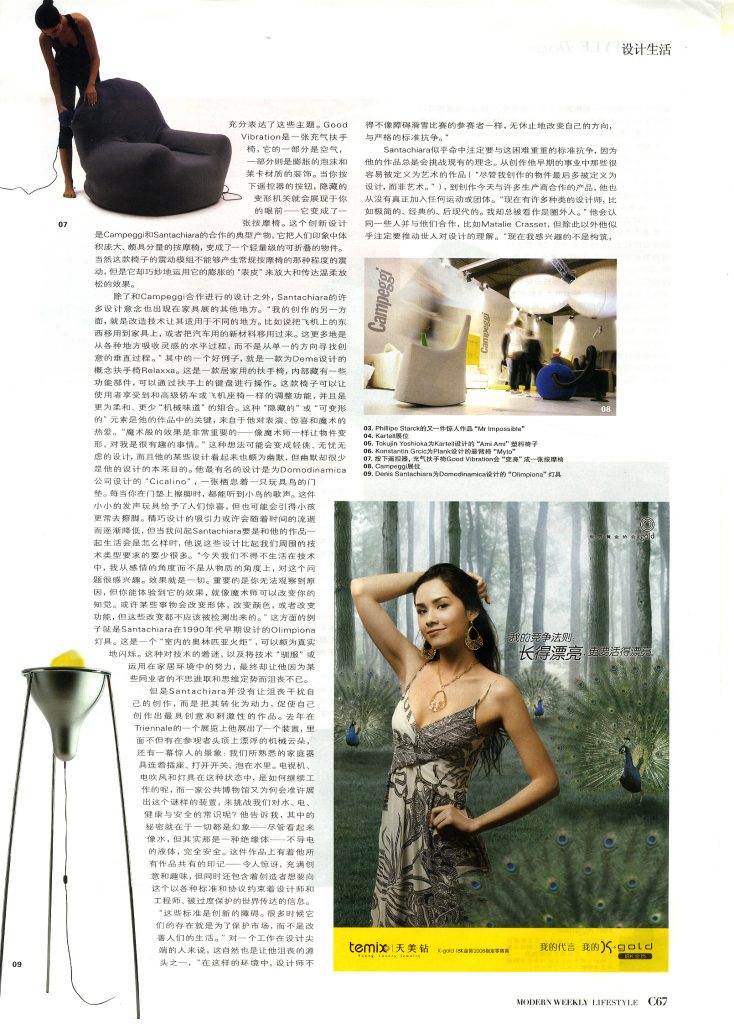
“To me the notion of two trees talking to one another is far more interesting than building something.”
Having forgotten all about their aching feet from walking the miles of aisles, and their strained arms and shoulders from carrying the thousands of product promotions, last month the global design crowd returned to Milan for another week of looking at chairs and going to parties. Despite uncertainties and pessimism in the industry, there was little sign of a slowing pace or tightening budgets here. Whilst the aim of the show is to do business, it is also a time for celebration, networking and eavesdropping for everyone involved. For me, it is a chance to keep up to date with developments and trends, whilst marvelling at the excesses of this industry, which has the capacity to take itself extremely seriously.
First stop is the Salone Del Mobile, held in the fairgrounds to the north of the city. This vast complex houses 2,450 exhibitors in 230,000 m³ of exhibition space. If this sounds like a daunting prospect, you would be right, but don’t be put off! The contemporary design junkie need only concern themselves with about 1/5 of all this – the halls showing contemporary, modern and ‘design’ furniture.
Unsurprisingly the usual nonsense was to be found around every corner. In a bid to attract, manufacturers were claiming in bold terms about their relentless pursuit of innovation, a no-compromise approach, being unafraid to break the rules. While at the same time showing collections either the same as last year, or the same as everyone else. Free food and drink is another surefire ploy to get people talking in positive tones about your product. Or at least turning up at your stand. In one showroom in the city, I saw a DJ being set up next to a new model of boardroom table. One can’t help thinking that as a PR exercise, this was taking things a little too far.
If you don’t even have a boardroom table to promote, and your product is basically a commodity, with little room for manoeuvre or differentiation design-wise, the best thing to do, apparently, is to hire in some glamour, and get somebody famous and flamboyant to do something unnecessary to it. The undisputed kings of this strategy are Bisazza, who make little ceramic and glass tiles, and Swarovski, who make crystals of various shapes and sizes. Both failed to escape enlisting the talents of one-man kitsch revival, Jaime Hayon, who for Bisazza created a full-size mosaic-covered aircraft with a Playboy-mansion style seating ‘pod’ stuck in the middle. All highly entertaining, and beautifully pointless. Over at Swarovski, the most novel work focused on embedding the crystal in another material. Current toast of the design world, Tokujin Yoshioka had giant ones sitting in acrylic blocks. “Floating Stars,” he calls them, while Swedish collective Front managed to work smaller crystals into molten glass vessels to create many varied and striking effects. Despite appreciating the artistry, however, I couldn’t help thinking it looked a bit like a candy you had dropped on the sidewalk.
Plastic Chairs
One of the big manufacturers that didn’t have to resort to such strategies was Kartell. This company is always a must-see because of their genuine approach to innovation and their patronage of the biggest names in design. Appropriate for a company founded by a chemical engineer 60 years ago, the focus is on plastics and experimenting with all the possibilities these materials afford. This year, the company launched 20 new products. This would be a lot for any company, but is remarkable because of the technical challenge each of them represents. The most striking were creations from Ronan and Erwan Bouroullec, Tokujin Yoshioka, Patrick Jouin, and Phillipe Starck, all of whom desmonstrated exciting new possibilities in translucent polycarbonate. The focus is mainly on the integration of complex surface effects although the Bouroullec chair was notable for its use of a cleverly moulded skeleton structure. One of Starck’s creations, Mr Impossible, manages to make the seat of the chair ‘float’ above the other components. This is a demonstration of a new application of laser technology to chair manufacture, by the 3d precision welding of the two halves of the chair.
Also working in plastics, this time a technical material called PBT (more commonly associated with highly engineered components) was Konstantin Grcic. This project is considered such a breakthrough that it was shown not only at the fair to potential buyers, but was also the subject of its own exhibition at the Triennale, where visitors could follow its development from sketches, through to prototypes and then the finished product. Much of the commentary focuses on the heritage of the cantilever chair. If you are not sufficiently obsessed by chairs, this is the type of chair that doesn’t have four legs, but supports your weight (normally by metal tubes) from just one direction. There have been very few plastic chairs with this design because of the demanding characteristics required of the material. It has to be both rigid and flexible, like metal. The only really successful design previous to Grcic’s version has been Verner Panton’s iconic one-piece chair.
A less academic, albeit more fun, comment on the one-piece cantilever chair could be found on the Casamania stand, where a Verner Panton chair had been reimagined in a more suggestive form. “Him & Her,” by Fabio Novembre has modelled the back section of the chair with a human form that treads a fine line between high camp and 1960’s erotic art.
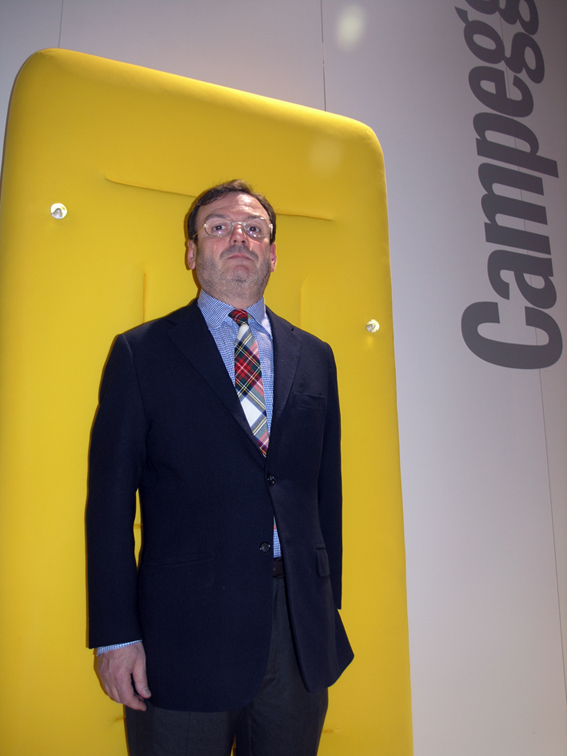
Campeggi and Santachiara. For many people visiting the show, it is an object lesson in ostentation. Much of the furniture would look terrible in most of our houses, or simply wouldn’t fit. It would be nice to have acres of polished marble or resin from which to eat one’s breakfast, but the reality for most of us is a little more modest. While the focus for the majority of mainstream, mass-market retailers is about space saving and finding more storage, most of the stuff you see in Milan appears to be about taking up as much room as possible. If you have a small space, however, and want to do something clever with it, the company with the most fun and innovative ideas has to be Campeggi. The firm, founded in 1958 by Luigi Campeggi and now run by his son, Claudio, produces a huge variety of ‘convertible’ furniture and appliances. Approaching their stand, you know that you are not looking at an ordinary company. Beneath giant animatronic butterfly wings, assistants in uniform demonstrate the brightly coloured products in a choreographed sequence of folding, switching, turning, inflating, pulling, pushing and sliding. Beds turn into storage units, chairs become exercise machines, poufs become vacuum cleaners, suitcases become chairs, and then turn into beds. Every object is unlike the last, and every one contains a surprise. If Willy Wonka gave up on confectionary and went into the furniture business, this is the sort of company he would run. Mr Campeggi himself presides over the whole scene in a not unwonka-like manner and one feels that he must take great pleasure in the endless stream of fascinated visitors. The majority of Campeggi products deal with beds that can be also used as sofas or chairs. Rather than use standard components, though, each of these is engineered to make them not just comfortable beds, but also comfortable and good-looking chairs. Looking at the range of products and the inventive spirit behind each one is a great way of reviving ones interest in furniture and all the possibility it offers in the right hands. For today’s cramped urban spaces this has to be the most practical stuff on offer at the fair. It is, perhaps, no coincidence that ‘Campeggi’ in Italian means ‘to go camping,’ the fun and practical aspect of which is well captured in the collection. A couple of the new products on display, (along with the giant butterfly wings), were created by one of Mr Campeggi’s long-time collaborators, Denis Santachiara, a man who evidently shares this passion for the unexpected. In order to find out more, I visited Santachiara at his canal-side studio, in the southern part of the city.
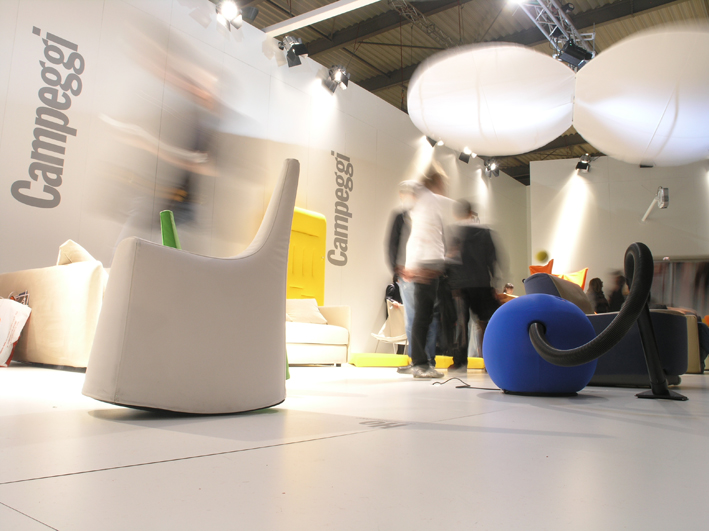
Like the majority of studios in the Milan, work does not stop just because the fair is on, and I found the designer busy at his desk, trademark cigar in hand. I started by asking him about his association with the Campeggi firm. “They are peculiar in their interest in transforming objects. Their approach fits closely with my interest in performance, and animated, poetic objects. Also the aspect of surprise, the use of soft materials and the integration of technology.” Nowhere are these themes more clearly expressed than in the piece by Santachiara launched at this year’s Salone, “Good Vibration.” This is an inflatable armchair, part air, part expanded foam and upholstered in lycra. The hidden transformation is revealed when you activate the remote control — it becomes a massage chair. This innovation is typical of the synergy between Campeggi and Santachiara in that something like a massage chair, which one associates with bulk and weight, can become a lightweight, collapsible object. Sure, the vibration module can’t deliver the same pressure as a regular massage chair, but it cleverly makes use of its inflated ‘skin’ to amplify and transmit the gentle, relaxing effect.
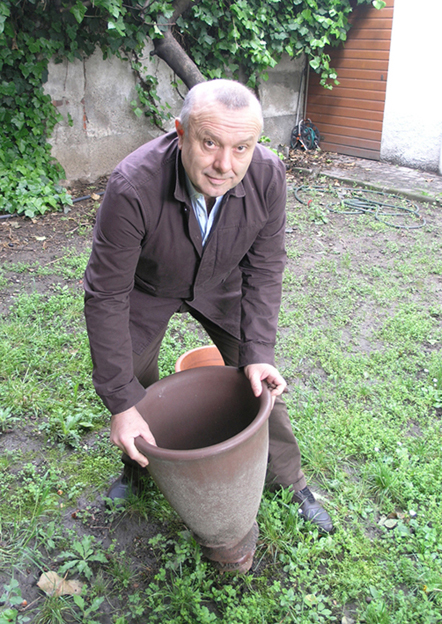
Along with the work being shown by Campeggi, Santachiara also had a number of other concepts being launched elsewhere in the show. “Another aspect of my work is to adapt technology from one area to another. For example from an aeroplane to furniture, or new materials from a car. The process is horizontal, taking inspiration from everywhere, rather than vertical, where innovation looks in one direction only.” A good example of this is a new armchair concept, Relaxxa, for Dema. This is a domestic armchair with an internal armature that can be configured through a keyboard in the armrest. It gives the user the same sort of control you would expect in a high-end car or aircraft seat, but in a much softer, less ‘mechanical,’ package. This ‘hidden’ or ‘transformative’ element is key to his work, which is also informed by a love of performance, surprise and magic. “The magical is very important — the ability to transform something in the manner of a conjuror is interesting to me.” This can suggest a frivolous, or light-hearted approach to design, but although some of his work appears humorous, this is rarely the aim in itself. One of his best-known pieces, “Cicalino,” for the company Domodinamica, has a whistling toy bird perched above a doormat. Every time you wipe your feet, you are rewarded with a little birdsong. This is an expression of something delightful and unexpected in the little singing toy, but might also encourage kids to wipe their feet more often. It is tempting to suggest that the effect of these ingenious pieces would wear off over time, but when asked what it would be like to live with his work, Santachiara describes how they could be seen as less demanding than the types of technology with which we find ourselves surrounded. “Nowadays we have to live with technology. I am interested in this from a sensorial, rather than a physical perspective. The effect is everything. It is important that you can’t see the cause but you can experience the effect, in the same way that a magician can alter your sense of perception, so – maybe something will change shape, or change colour, or change its function, but this should be undetectable.” An example of this is the much-copied Olimpiona lamp designed by Satachiara in the early 1990’s. This is an ‘Olympic flame for interiors’ that flickers in a highly realistic manner. This fascination with technology and how it can be ‘tamed’ or made acceptable in a domestic setting has inevitably led to frustrations with the less progressive mindset of some sectors of the industry.
Rather than let this frustration disrupt his work, though, Santachiara manages to turn it on its head and use it as a driver for some of his most inventive and provocative work. For an exhibition last year at the Triennale, he created an installation that not only incorporated a number of robotic clouds shifting about over visitors’ heads, but also the alarming sight of familiar household appliances plugged-in, switched on and submerged in bowls of water. How the televisions, hairdryers and lamps managed to keep functioning in this state, and how a public museum could allow such a seemingly lethal show was a mystery that ran counter to everything we are taught about water, electricity, health and safety. The secret, he tells me, is that it’s an illusion – although it looks and behaves like water, it is in fact a dielectric – a non-conductive liquid, and completely safe. Whilst bearing all the hallmarks of his work – inventive, surprising and playful – the piece contained a more profound message from its creator about the over-protective nature of the various standards and protocols under which designers and engineers have to work. “These standards are a barrier to innovation. Too often, they appear to exist for market protection rather than an improvement of people’s lives.” For someone who is constantly working at the edge of what technology can offer, this is clearly a source of frustration, “In this situation, the designer has to work like a skier in a slalom race – forever changing direction to negotiate the rigid standards.”
It seems that Santachiara is destined to negotiate this difficult terrain as his work is always set to challenge existing ideas. From his early career, which could be located more readily in an art context (“although the objects I made always turned out as ‘design’ rather than ‘art.’”) to today when he works with a variety of enlightened manufacturers, he has never really been part of any movement or group. “There are lots of categories of designer out there, such as ‘minimalist,’ ‘classicist,’ ‘postmodernist.’ I am always viewed as an ‘outsider’ in this case.” There are people, Matalie Crasset, for instance, with whom he identifies, and has worked with in the past, but other than this, he seems destined to push the understanding of design even further. “Nowadays I am interested not in building, but in not building – in the removal of building from the equation,” he says. The massage chair might be seen as an example of this, as it succeeds in removing physical bulk from a massive object, but Santachiara has a better illustration. “I was invited to propose ideas for the entrance to a new park.” Clearly, the planners wanted a striking ‘designer’ gate that would provide a sculptural diversion or talking point. Santachiara couldn’t bring himself to do this, though. “The client wanted a gate, but to me the notion of two trees talking to one another is far more interesting than building something. I work with the ideas that every object can think, speak and has a memory. If you have two trees, one artificial and one real, able to move and sway through mechanical means, their conversation would be an ideal way to frame the entrance to a park.” Sadly, this idea is unlikely to be realised in this form, but this will not dissuade Santachiara, who always seems to find novel outlets for his ideas. As we left the studio, he demonstrated a prototype for a combined ceiling lamp and fan. Not one of those nasty brass reproduction affairs, you understand, but a fan, where the blades themselves are illuminated. And out in the garden he demonstrated one of his most iconic creations – the Santavase – designed for Italian manufacturer Serralunga. Their range of ‘designer’ pots and planters in polypropylene have helped re-imagine the archetypal terracotta object in a myriad of forms. Amongst these, Santavase stands out as being a pre-cursor to that conversation between trees. With its screw-in base, it is as though the pot is providing a mechanical root for a living plant. It is both unexpected and delightful – a talent for which Santachiara shows no sign of letting go of.
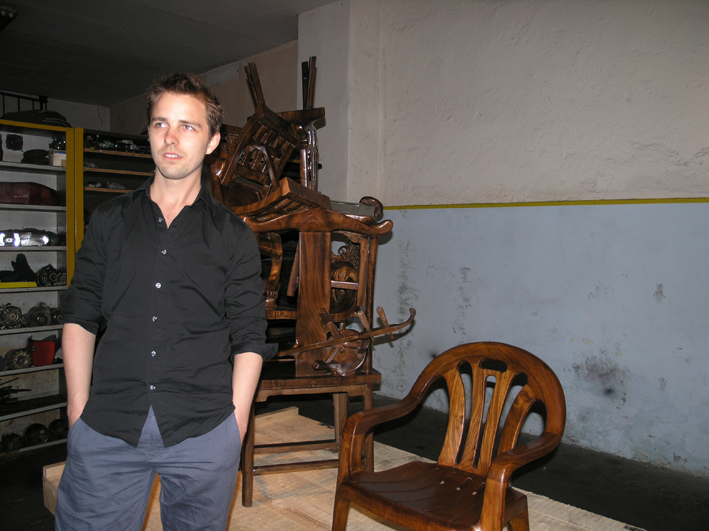
Maarten Baas. Last year I reported on the novel and inventive output of Maarten Baas’ studio in Eindhoven. This year was no different, as tucked away a few doors down from last year’s venue, he was to be found with his team again showing some of the most striking and playful work around. Rather than show the work in the pristine surroundings of a gallery, or spend a fortune on building a stand, Baas chose to show in a working garage. Visitors were invited to make their way around the tools and machinery to see his latest work. This lent the show an informal atmosphere that visitors clearly enjoyed. Along with his famous Smoked (i.e. burned), Sculpt (wavy) and Clay (wobbly) pieces, there were a couple of new commissions on show. The first, for British Company Established and Sons consisted of a ‘family’ of furniture, and could be found hidden behind a barrier in the workshop. Despite being fashioned in the same bright colours as the Clay furniture, these strange creatures represent a departure for Baas in that they are less to do with processes of design and manufacture, and more about exploring the possibilities, and definitions, of furniture. With their strange blinking lights, tentacles and odd proportions they resemble cartoon aliens come to life. As if to reinforce this, Baas himself seems unsure as to how they came about. “They don’t really mean anything or come from anywhere – It just seemed like a great opportunity to try something different.”
Alongside these, some of the most commented-upon pieces were from his recent show in China; an opportunity which he used to work with local craftsmen to create a wooden plastic chair and a Chinese version of his “Hey Chair, be a Bookshelf.” While all his work is hand made, they are not normally carved out of solid timber like these two. “I always wanted the ‘Hey Chair’ pieces to look as though they were made from the same material. It is something I have been able to realise with this project,” he said. The ‘plastic’ chair is so accurate it looks as though it has been milled by a machine. “No, no, it’s carved by hand,” says Baas, “I took a plastic chair, which seems to be impossible to make in wood, but after adjusting some of the thicknesses and details, we found that it could work.”
“What I like about the plastic chair is its anonymity. We rarely notice them, yet they are everywhere. After making this, I will definitely look at plastic chairs in a different way.”
Having spent the previous week looking at nothing but chairs – plastic, metal, wood and every imaginable combination thereof, I, for one, will be happy not to look at them at all for at least a couple of months.
© Ben Hughes 2008
web:
http://www.konstantin-grcic.com
www.maartenbaas.com
Images:
Fritzhansen.jpg
A DJ being set up to celebrate the launch of a new boardroom table.
Image: ©Ben Hughes
Kartellstand.jpg
http://www.denisantachiara.it/
Kartell Stand at Salone Del Mobile 2008.
Image: Kartell
FRONTrandomlycrystal2.JPG
“Randomly Crystal” piece by Front for Swarovski
Image: ©Ben Hughes
Tokujin Yoshioka2.JPG
“Eternal” by Tokujin Yoshioka for Swarovski
hayonBisazza.JPG
“Jet Set” Jaime Hayon for Bisazza
Image: ©Ben Hughes
Papyrus01.jpg
“Papyrus” chair by Ronan and Erwan Bouroullec for Kartell.
Image: Kartell
Ami Ami 02.jpg
“Ami Ami” chair by Tokujin Yoshioka for Kartell
Image: Kartell
starckmrimpossible.jpg
“Mr Impossible” chair by Philippe Starck for Kartell
Image: Kartell
PatrickJouinThalya.JPG
“Thalya” Chair by Patrick Jouin for Kartell
Image: ©Ben Hughes
GrcicMyto.JPG
“Myto” Chair by Konstantin Grcic for Plank
Image: ©Ben Hughes
HimHerFabioNovembre0.JPG
“Him and Her” Chair by Fabio Novembre for Casamania.
Image: ©Ben Hughes
Campeggi1.jpg
Campeggi Stand at 2008 Salone Del Mobile
Image: ©Ben Hughes
Campeggi2.jpg
The author trying out Good Vibration chair
Image: ©Ben Hughes
Campeggi4.jpg
Claudio Campeggi
Image: ©Ben Hughes
Cicalino.jpg
“Cicalino” doormat, designed by Denis Santachiara
Image: ©Domodinamica
OLIMPIONA.jpg
“Olimpiona” Lamp by Denis Santachiara for Domodinamica.
Image: ©Domodinamica
good_vibration_01.jpg
Inflating the “Good Vibration” Chair by Denis Santachiara
Image: ©Campeggi srl
Santachiarainstallation.JPG
Installation at the Triennale 2007 by Denis Santachiara.
Image: ©Ben Hughes
COVERsantachiara19.jpg
Denis Santachiara (possible cover image)?
Image: ©Ben Hughes
santachiara12.jpg
Denis Santachiara
Image: ©Ben Hughes
relaxxa.jpg
“Relaxxa” hi-tech recliner by Denis Santachiara for Dema
Image: ©Dema
maartenbaas20080.JPG
Maarten Baas with carved plastic chair and Chinese version of “Hey Chair, be a Bookshelf”
Image: ©Ben Hughes
maartenbaas20086.JPG
Maarten Baas’ Chinese project — a carved ‘plastic’ chair and Chinese version of “Hey Chair be a Shelf!”
Image: ©Ben Hughes
maartenbaas20082.JPG
“The Chankley Bore” by Maarten Baas for Established and Sons.
Image: ©Ben Hughes
